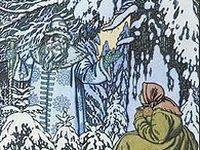Christmas and New Year
St. Nicholas is the patron of Russia, of sailors and children, the benevolent figure who brings gifts on December 6th, December 25th or on January 6th, depending on the country and the religion / culture. In Russia, Christmas Eve is celebrated on January 6, or Epiphany, the day when the Wise Men came to worship Jesus. Presents are usually exchanged at the New Year's Party in Russia.

Who was Father Christmas?
Saint Nicholas existed in the flesh. He was born in Mira, Asia Minor, the city of which he became Bishop, in the fourth century AD. He became tied to gift-giving due to the many stories of his generosity, as he distributed his considerable wealth among the poor and in favour of social causes.
Originally, gifts were given on the 6th of December (Saint Nicholas' Day) but this was changed when in the fourth century, Pope Julius (337-352) set the 25th of December as the day of the birth of Jesus, because it was a day that coincided with the Roman festival of Saturnalia, and the Germanic and Celtic pagan festivities of the winter Solstice (December 21). It was in the thirteenth century that the habit of building cribs to celebrate Christ's birth began.
Father Xmas is Russian
The Orthodox Church then changed this festival to the Day of Epiphany (day of the adoration, the 6th of January), when the Three Kings/Wise Men/Zoroastrian astrologists brought presents for the baby Jesus in the stable. It is on this day that Christmas is celebrated in Russia, but who brings the gifts are Ded Moroz (Grandfather Frost), and Snegoroshka (The Snow Girl). Ded Moroz is perhaps the original Santa Claus, with his white long beard and his long clothes. Traditionally, he was clad in different coloured robes but inthe west, the Coca-Cola campaign of the 1920s saw him become accepted and customized in red and white.
April Fools' Day, Carnival, Easter...
New Year was originally celebrated on April 1, not January 1. April 1 was near the time of the Vernal Equinox (March 21) and is the time of the rebirth of agriculture, celebrated by fertility festivals from February (Carnival) onwards, until Easter (which takes its name from the Pagan Fertility Goddess Eostre, depicted on rock engravings holding the symbol of fertility, a rabbit and the symbol of eternity, an egg).
In 1582 Pope Gregory XIII ordered the Gregorian Calendar to replace the Julian one and this new calendar called for New Year to be celebrated in January. Some say that the newly enlightened, more educated people accepted this date and the traditionalists in the countryside did not, and as they retained April 1, they were called fools or liars.
However, the beginning of April coinciding with the fertility festivals, it is likely that in popular cultural expressions, dances, songs and games were performed, along with dressing up in costumes to represent good (fertility) spirits. The Roman festival of Hilaria was performed on March 25, and celebrated the Resurrection of Attis.
Timothy Bancroft-Hinchey
Pravda.Ru
Subscribe to Pravda.Ru Telegram channel, Facebook, RSS!


